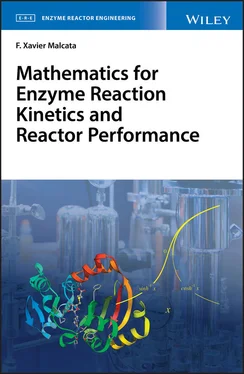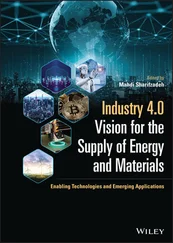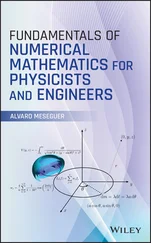An innovative approach is thus in order, where fundamental and applied aspects pertaining to enzyme reactors are comprehensively tackled – built upon mathematical simulation, and encompassing various ideal and nonideal configurations, presented and discussed in a consistent and pragmatic way. Enzyme Reactor Engineering pursues this goal, and accordingly conveys the most integrated and complete treatment of the subject of enzyme reactors to date; it will likely materialize a qualitative leap toward more effective strategies of describing, designing, and optimizing said reactors. More than a mere description of technology, true engineering aspects departing from first principles are put forward, and their rationale is systematically emphasized – with special attention paid to stepwise derivation of the underlying equations, so as to permit a self‐paced learning program by any student possessing elementary knowledge of algebra, calculus, and statistics. A careful selection of mathematical tools deemed useful for enzyme reactors is also provided in dedicated volumes, for the more inquisitive students and practitioners – in a straightforward, yet fully justified manner. Furthermore, appropriate examples, based (at least) on Michaelis and Menten’s enzymatic kinetics and first‐order enzyme decay, are worked out in full – for their being representative of industrial situations, while exhibiting a good compromise between practical applicability and mathematical simplicity. In this regard, the present book collection represents an unparalleled way of viewing enzyme reactors – clearly focused on the reactor component but prone to build an integrated picture, including mixture via momentum and mass transfer, and subsequent transformation via chemical reaction, with underlying enthalpic considerations as found necessary.
In a word, Enzyme Reactor Engineering attempts to contribute to a thorough understanding of the engineering concepts behind enzyme reactors – framed by a rigorous mathematical and physically consistent approach, and based on mechanistic expressions describing physical phenomena and typical expressions for enzyme‐mediated kinetics and enzyme decay. It takes advantage of a multiplicity of mathematical derivations, but ends up with several useful formulae while highlighting general solutions; and covers from basic definitions and biochemical concepts, through ideal models of flow, eventually to models of actual reactor behavior – including interaction with physical separation and external control. The typical layout of each chapter accordingly includes: introductory considerations, which set the framework for each theme in terms of relevance; objective definition, which entails specific goals and usefulness of ensuing results; and mathematical stepwise development, interwoven with clear physicochemical discussion (wherever appropriate), which resort to graphical interpretations and present step‐by‐step proofs to eventually generate (duly highlighted) milestone formulae. All in all, such an approach is aimed at helping one grasp the essence of descriptive functions, as well as the meaning behind hypothesized parameters and attained optima. Selected papers, chapters, or books are listed at the end, for more in‐depth, complementary reading – aimed at reinforcing global overviews.
Enzyme Reactor Engineering is organized as four major sets, which support a self‐consistent and ‐contained book collection: Enzyme Reaction Kinetics and Reactor Performance , Analysis of Enzyme Reaction Kinetics , Analysis of Enzyme Reactor Performance , and Mathematics for Enzyme Reaction Kinetics and Reactor Performance . Such a philosophy is primarily intended to help the prospective learner evolve in their knowledge acquisition steps – although it also constitutes standard material suitable for instructors; and allows the reader to first grasp the supporting concepts before proceeding to a deeper and deeper insight on the detailed kinetics of reactions brought about by generic enzymes, and eventually extending said concepts to overall reactor operation using enzymes. Three levels of description are indeed apparent and sequentially considered in the core of this book collection: macroscopic, or ideal; microscopic, or nonideal in terms of hydrodynamics (including homogeneous, nontrivial flow patterns) and mass transfer (including multiphasic systems); and submicroscopic, or nonideal in terms of mixing. The quality of the approximation increases in this order – but so does the complexity of the mathematical models entertained, and the thoroughness of the experimental data required thereby.
This treatise on reactors, using enzymes as catalysts, should be usable by and useful to both (advanced) undergraduate and graduate students interested in the fascinating field of white biotechnology, and typically enrolled in chemical or biochemical engineering degrees; as well as industrial practitioners involved in conceptual design or concerned with rational optimization of enzyme‐mediated processes. Enzyme Reactor Engineering has been conceived for hybrid utilization as both text and reference – since virtually all topics of relevance for enzyme reactors are addressed to some extent, and carefully related to each other.
F. Xavier Malcata Professor of Chemical Engineering University of Porto (Portugal)
Quality is not an act, it is a habit.
Aristotle
Mathematics for Enzyme Reaction Kinetics and Reactor Performance is the first set in a unique 11‐volume collection on Enzyme Reactor Engineering . This two‐volume set relates specifically to the mathematical background – required for systematic and rational simulation of both reaction kinetics and reactor performance, and to fully understand and capitalize on the modelling concepts developed; it accordingly reviews basic and useful concepts of Algebra (first volume), and Calculus and Statistics (second volume).
A brief overview of such native algebraic entities as scalars, vectors, matrices, and determinants constitutes the starting point of the first volume; the major features of germane functions are then addressed – namely, polynomials and series (and their operative algebra), as well as trigonometric and hyperbolic functions. Vector operations ensue, with results either of scalar or vector nature, complemented by tensor/matrix operations and their properties. The calculation of determinants is considered next – with an emphasis on their underlying characteristics, and use to find eigenvalues and -vectors. Finally, exact methods for solution of selected algebraic equations, including sets of linear equations, are addressed – as well as numerical methods for utilization at large.
The second volume departs from introduction of seminal concepts in calculus, i.e. limits, derivatives, integrals, and differential equations; limits, along with continuity, are further expanded afterward, covering uni‐ and multi‐variate cases, as well as classical theorems. After recovering the concept of differential and applying it to generate (regular and partial) derivatives, the most important rules of differentiation of functions (in explicit, implicit, and parametric forms) are retrieved – and the most relevant theorems supporting simpler manipulation thereof are reviewed. Once the conditions for independence of functions are put forward, the strategies to optimize uni‐ and multi-variate functions are tackled – either in the presence or absence of constraints. The concept of integral is finally discussed, in both indefinite and definite forms – and the fundamental theorems are brought on board, along with the rules of integration. Furthermore, optimization of integrals is discussed, as part of calculus of variations. Practical applications of the concept of derivative follow – namely, for development of Taylor’s series and setting of associated convergence criteria; and also of the concept of integral – namely, to define the gamma function and to take advantage of its ubiquitous properties. Due to their relevance in reactor modelling, fundamental concepts in analytical geometry are recalled – with an emphasis on curves, surfaces, and volumes bearing simple (yet representative) shapes. Finally, the working horse of process modelling is covered to some length – i.e. (ordinary) differential equations, including such useful tools for solution thereof as Laplace’s integral (and Legendre’s derivative) transforms – with a brief excursion to solution of (first order) partial differential equations. The most important methods of analytical solution available are duly reviewed and eventually complemented with simple numerical approaches to integration. The final topic is vector calculus – where the nuclear del operator is introduced, and the most important applications to scalar and vector entities are developed as identities expressed in rectangular coordinates; an extension is made later to cylindrical and spherical coordinates, for the sake of completeness.
Читать дальше












